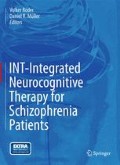Additional material (CD-ROM) to this book can be downloaded from http://extras.springer.com
Access this chapter
Tax calculation will be finalised at checkout
Purchases are for personal use only
References
Baddeley, A. D. (1986). So denkt der Mensch. München: Droemer-Knaur.
Barch, D., & Carter, C. (2005). Amphetamine improves cognitive function in medicated individuals with schizophrenia and in healthy volunteers. Schizophr Res, 77(1), 43–58.
Bäuml, J., & Pitschel-Walz, G. (2008). Psychoedukation bei schizophrenen Erkrankungen (2nd ed.). Stuttgart: Schattauer.
Bäuml J, Pitschel-Walz G, Berger H, Gunia H, Heinz A, Juckel G (2010) (2008) Arbeitsbuch PsychoEdukation bei Schizophrenie, 2. Auflage. Schattauer, Stuttgart
Ekman, P. (1993). Facial Expression and Emotion. American Psychologist, 48(4), 384–392.
Ekman, P., & Friesen, W. V. (1976). Pictures of facial affect. Palo Alto: Consulting Psychologists Press.
Green, M. F., & Nuechterlein, K. H. (2004). The MATRICS initiative: developing a consensus cognitive battery for clinical trials. Schizophr Res, 72, 1–3.
Green, M. F., Olivier, B., Crawley, J. N., Penn, D. L., & Silverstein, S. (2005). Social cognition in schizophrenia: recommendations from the measurement and treatment research to improve cognition in schizophrenia new approaches conference. Schizophr Res, 31, 882–887.
Groß, J. J. (1998). The emerging field of emotion regulation: an integrative review. Rev Gen Psychol, 2, 271–299.
Groß, J. J., & Thompson, R. A. (2007). Emotion regulation: conceptual foundations. In J. J. Groß (Ed.), Handbook of emotion regulation (pp. 3–24). New York: Guilford Press.
Hodel B (1998) Einschätzung von “Emotionsfotos”: Auswertung der Daten. Unveröffentlichtes Arbeitspapier. Universitätslinik und Poliklinik für Psychiatrie, Bern
Kern, R. S., Liberman, R. P., Kopelowicz, A., Mintz, J., & Green, M. F. (2002). Applications of errorless learning for improving work performance in persons with schizophrenia. Am J Psychiatry, 159(11), 1921–1926.
Kern, R. S., Green, M. F., Mintz, J., & Liberman, R. P. (2003). Does ‘errorless learning’ compensate for neurocognitive impairments in the work rehabilitation of persons with schizophrenia? Psychol Med, 33(3), 433–442.
Kern, R. S., Green, M. F., Mitchell, S., Kopelowicz, A., Mintz, J., & Liberman, R. P. (2005). Extensions of errorless learning for social problem-solving deficits in schizophrenia. Am J Psychiatry, 162, 513–519.
MATRICS Assessment, Inc (2006) Matrics consensus cognitive battery (MCCB). Retrieved from http://www.matricsinc.org/MCCB.htm#1. Accessed May 2009
Medalia, A., & Thysen, J. (2008). Insight into neurocognitive dysfunction in schizophrenia. Schizophr Bull, 24, 1221–1230.
Miller, W. R., & Rollnick, S. (2009). Motivierende Gesprächsführung (3rd ed.). Freiburg: Lambertus.
Müller, D. R., & Roder, V. (2008). Empirical evidence for group therapy addressing social perception in schizophrenia. In J. B. Teiford (Ed.), Social perception: 21st century issues and challenges (pp. 51–80). New York: Nova.
Müller, D. R., & Roder, V. (2010). Integrated psychological therapy (IPT) and integrated neurocognitive therapy (INT). In V. Roder & A. Medalia (Eds.), Neurocognition and social cognition in schizophrenia patients. Basic concepts and treatment (pp. 118–144). Basel: Karger.
Müller, D. R., & Roder, V. (2012). Integrierte Neurokognitive Therapie. Kognitionen als Interventionsziel bei schizophren Erkrankten. Neurol Psychiatrie, 14(4), 57–63.
Nakagami, E., Xie, B., Hoe, M., & Brekke, J. S. (2008). Intrinsic motivation, neurocognition and psychosocial functioning in schizophrenia: testing mediator and moderator effects. Schizophr Res, 105, 95–104.
Nuechterlein, K. H., Barch, D. M., Gold, J. M., Goldberg, T. E., Green, M. F., & Heaton, T. E. (2004). Identification of separable cognitive factors in schizophrenia. Schizophr Res, 72, 29–39.
Olbrich, R. (1996). Computer based psychiatric rehabilitation: current activities in Germany. Eur Psychiatry, 11, 60–65.
Olbrich, R. (1998). Computergestutzte psychiatrische Rehabilitation. Psychiatr Prax, 25(3), 103–104.
Olbrich, R. (1999). Psychologische Verfahren zur Reduktion kognitiver Defizite. Erfahrungen mit einem computergestutzten Trainingsprogramm. Fortschr Neurol Psychiatr, 67(Suppl 2), 74–76.
Roder, V., Brenner, H. D., Kienzle, N., & Hodel, B. (1988). Integriertes Psychologisches Therapieprogramm (IPT) für schizophrene Patienten. München: Psychologie Verlags Union.
Roder, V., Brenner, H. D., & Kienzle, N. (2002). Integriertes Psychologisches Therapieprogramm für schizophren Erkrankte (IPT) (5th ed.). Weinheim: Beltz.
Roder, V., Brenner, H. D., & Kienzle, N. (2008a). Integriertes Psychologisches Therapieprogramm bei schizophren Erkrankten IPT, 6. überarbeitete Auflage. Weinheim: Beltz.
Roder, V., Zorn, P., Pfammatter, M., Andres, K., Brenner, H. D., & Müller, D. R. (2008b). Praxishandbuch zur Verhaltenstherapeutischen Behandlung schizophren Erkrankter (2nd ed.). Bern: Huber.
Roder, V., Müller, D. R., Brenner, H. D., & Spaulding, W. D. (2010). Integrated Psychological Therapy (IPT) for the treatment of neurocognition, social cognition, and social competencies in schizophrenia patients. Göttingen: Hogrefe.
Roder, V., Müller, D. R., & Schmidt, S. J. (2011). Effectiveness of the Integrated Psychological Therapy (IPT) for schizophrenia patients: a research up-date. Schizophr Bull, 37(Suppl 2), 71–79.
Schank, R. C., & Abelson, R. (1977). Scripts, plans, goals, and understanding. Hillsdale: Earlbaum Assoc.
Velligan, D. I., Kern, R. S., & Gold, J. M. (2006). Cognitive rehabilitation for schizophrenia and the putative role of motivation and expectancies. Schizophr Bull, 32, 474–485.
Author information
Authors and Affiliations
Corresponding authors
Editor information
Editors and Affiliations
Rights and permissions
Copyright information
© 2015 Springer International Publishing Switzerland
About this chapter
Cite this chapter
Müller, D.R., Schmidt, S.J., Lächler, M., Roder, V. (2015). Practical Implementation of INT. In: Roder, V., Müller, D. (eds) INT-Integrated Neurocognitive Therapy for Schizophrenia Patients. Springer, Cham. https://doi.org/10.1007/978-3-319-13245-7_2
Download citation
DOI: https://doi.org/10.1007/978-3-319-13245-7_2
Publisher Name: Springer, Cham
Print ISBN: 978-3-319-13244-0
Online ISBN: 978-3-319-13245-7
eBook Packages: Behavioral ScienceBehavioral Science and Psychology (R0)

